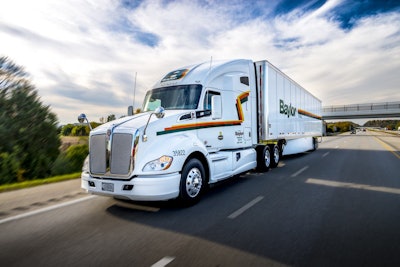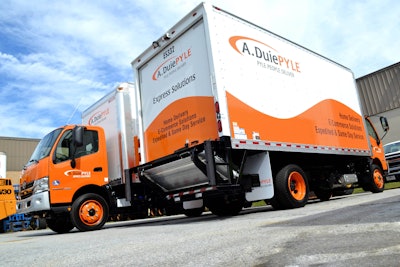Editor’s note: This is the second and final installment of a series on the 2020 impact on the capacity and pricing strategies of shippers, carriers and 3PLs. Part one covered the freight bidding process.
Volatility in the freight market and tight capacity following a V-shaped recovery in the third quarter have made driver and asset utilization a top-of-mind concern for carriers. The recovery has created pressure on shippers and 3PLs to reduce detention times at facilities and offer more predictable freight schedules and appointment flexibility.
 Baylor Trucking increased its trailer fleet by 30% in 2020 to improve asset utilization and minimize detention times at shippers and receivers.
Baylor Trucking increased its trailer fleet by 30% in 2020 to improve asset utilization and minimize detention times at shippers and receivers.Dwell times, also referred to as detention, at shipping and receiving locations “were horrible” during the COVID-19 lockdown period from March through May, recalls Cari Baylor, president of Baylor Trucking, a Milan, Ind.-based truckload carrier with expedited dry van and refrigerated operations. She lays most of the blame to shippers and receivers having “trouble getting people to come to work.”
Baylor Trucking had a large increase in unpaid miles as a result of not having enough dropped trailers at shipper yards. Drivers were departing receivers without trailers amid chaos in supply chains that made it difficult to track and charge customers for detention, she said.
Analysis by FourKites, a freight visibility provider, shows that dwell times increased by 5% overall in 2020 with the highest increases in retail and manufacturing. Dwell time for retail shipments, as of Nov. 1, returned to January levels. FourKites credits this to retail having a more steady and predictable demand over the last 6 months that allowed facilities to better plan and staff up.
Manufacturing shipment volumes increased by 34% in October compared to January, and FourKites found the average dwell time peaked in September at 11%. In October it held steady at 10% over January levels, but demand in manufacturing has been far more lumpy and less predictable over the last 6 months. This has made it more difficult to plan at the facility level.
Overall, during the first 3 quarters of 2020, FourKites data shows dwell time was the highest on weekdays from 11 a.m. to 5 p.m., with Tuesday being the peak day.
During 2020, carriers have been able to add capacity by purchasing more trailers and using technology to better utilize their assets to limit detention times at shippers and receivers. Baylor Trucking, for instance, has increased its trailer fleet by more than 30% this year by adding 270 more trailers to its fleet, she said.
Minimizing dwell time has been a point of emphasis in 2020 for Capstone Logistics, a 3PL based in Atlanta that specializes in refrigerated shipments, to negotiate better rates with carriers. It starts with “making sure we are bringing freight that fits their network,” said John Ackerman, executive vice president of carrier procurement, to “create efficiencies and optimize the way we use equipment.”
Capstone has also focused on creating technology to drive a paperless supply chain as well as create safety and convenience for drivers. “We are studying the process of when a driver gets a load all the way to when driver gets paid to look for efficiencies,” he said.
One way the 3PL is reducing dwell time is by ensuring that drivers have received all the communications they need before arriving at shippers and receivers to start the check-in process, he said. Additionally, Capstone has streamlined the process of sending funds to drivers to pay for live unloading, which saves drivers between 10 and 30 minutes per event, he said.
Capacity challenges
Besides the increase in dwell times, much larger forces have been constraining the growth of capacity in truckload, LTL and final-mile sectors. Yet with those challenges also come new opportunities for all parties to gain a competitive advantage.
Truckload
Of the approximately 560,000 carriers registered with the Federal Motor Carrier Safety Administration, 89% operate no more than 10 trucks. Skyrocketing insurance costs are making it more difficult than ever for small fleets to stay in business, let alone add capacity.
 The “Amazon Effect” of e-commerce has raised expectations for service and faster delivery times across all transport modes.
The “Amazon Effect” of e-commerce has raised expectations for service and faster delivery times across all transport modes.After having a “very safe” year in 2019, Baylor Trucking saw its general liability insurance policy renewal stay flat in 2020. The cost of its umbrella coverage increased by 100%, however, which added more than $10,000 a month in operating costs, Baylor said.
Plains Dedicated, a 25-truck carrier and 3PL based in Orlando, Fla., had a 25% increase in general liability premiums, said John Miller, the company’s managing partner. In addition to higher costs, the company is having difficulty growing capacity as a result of stricter lending policies from banks. Specifically, banks have lowered their debt-to-equity ratios for equipment lending, he said, which is pushing owner-operators out of the market.
“There are a lot of things lined up against the trucker,” Miller said.
LTL
The LTL sector has seen mixed results in 2020 due to a shift in freight patterns caused by factory shutdowns and changes in consumer buying habits.
One area where LTL has been making a comeback is from fleets offering blended warehousing and delivery solutions to meet higher customer service expectations in the age of e-commerce.
One of the largest LTL carriers, A. Duie Pyle, outperformed the market in 2019 by growing its revenue by 10%. As of Mar. 13, the company’s daily bill count — a measurement of freight volume — was averaging 10,000, which was an increase of 8%, year over year.
In mid-April the daily bill count fell by 40% to bottom out at 6,000. The company does business with large shippers and stuck with its formula of providing competitive rates and the highest-possible service in the Northeast, said John Luciani, Pyle’s chief operating officer of LTL solutions.
The company operates along the I-95 corridor from Baltimore to Bangor, Maine. This region has the greatest population concentration in the United States, and Pyle has strategically opened warehouses in the largest metropolitan markets to offer customers a blended warehousing and next-day LTL service.
In 2020, Pyle added capacity for large customers by building additional cross dock facilities and warehouses, and by reducing the amount of transactional 3PL business, he said. Business picked up in July and as of October its daily bill count has returned to above 10,000, he said.
Final Mile
One of the biggest opportunities for carriers in 2020 has been the emergence of demand for residential delivery solutions for “big and bulky” items.
 A. Duie Pyle operates an Express Solution fleet of straight trucks (class 5 and 6) that have lift gates and a 2,500-pound payload capacity.
A. Duie Pyle operates an Express Solution fleet of straight trucks (class 5 and 6) that have lift gates and a 2,500-pound payload capacity.A. Duie Pyle operates an Express Solution fleet of straight trucks (class 5 and 6) that have lift gates and a 2,500-pound payload capacity. The company has seen a significant increase in residential deliveries for home improvement products from its customers, Luciani said.
Ryder, a provider of supply chain, dedicated transportation, and commercial fleet management services, created a Last Mile division in 2018 from an acquisition. In 2018, consumers were already comfortable with buying big and bulky products online for home delivery. That trend accelerated in 2020.
With the new division, Ryder offers an e-commerce sales channel to retailers and manufacturers that traditionally have sold products only to walk-in customers. During 2020, Ryder has capitalized on people spending money on household items instead of going on vacations, said Jeff Abeson, vice president of Ryder Last Mile.
Ryder also manages parcel shipments with an e-commerce service and provides Last Mile fulfillment of large items through its own network of warehouses, assets and driver teams. The e-commerce and fulfillment services have national coverage and visibility through a single operating platform.
Searching for stability
Although the freight market made a strong recovery in 2020, “no one knows what the new normal is going to be after the COVID-19 situation,” cautioned John Janson, senior director of supply chain for SanMar Corp., a large shipper of custom apparel items.
This uncertainty is making it difficult for shippers, 3PLs and carriers to use traditional RFP processes to negotiate and secure capacity commitments. Mini bids are becoming the norm, and supply chains have also become more demand-driven with the “Amazon Effect” of e-commerce raising the expectations for service and faster delivery times.
Going forward, all parties are eyeing changes to smooth the directional changes in freight pricing. SanMar, for instance, is currently talking with its most strategic carriers about long-term contracts that would allow rates to move up and down by a percentage based on pricing in the spot market, Janson said.
Editor’s note: The Transportation Intermediaries Association provided feedback and access to members on its shipper’s committee for this report.





![DIRECTOR_Driver Post Trip Feedback-Tablet-FINAL3[1]-2018-08-17-15-31](https://img.ccjdigital.com/files/base/randallreilly/all/image/2018/08/ccj.DIRECTOR_Driver-Post-Trip-Feedback-Tablet-FINAL31-2018-08-17-15-31.png?auto=format%2Ccompress&fit=crop&h=167&q=70&w=250)






